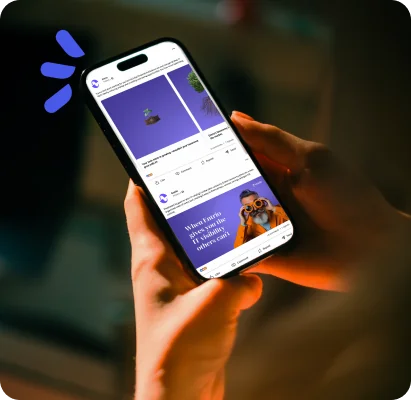
You did it—after all that effort, you finally secured the sale. Time to relax and return to the pipeline, right?
Not so fast. Growth doesn’t just come from attracting new customers. It comes from keeping the ones you already have excited, engaged and sticking around for the long haul.
Whether you're offering a product, service or software experience, long-term loyalty depends on how well you show up after day one.
This blog is packed with bold, practical strategies to help you deliver consistent value and build the kind of brand customers don’t want to quit.
Set your customers up for success
Your customer experience doesn’t start at launch—it starts at login. A strong start builds confidence and turns curious first-timers into loyal customers.
Onboard new customers
Make onboarding feel like a win, not a chore. Think clear, simple and just a little fun. Badges, milestone rewards, or a welcome email with personality can go a long way in creating early momentum.
Here are a few onboarding ideas worth testing:
- Host live or on-demand training: Offer a mix of formats—some people want a live walkthrough, others prefer to explore on their own.
- Create a digital resource hub: Use guides, videos and checklists to walk customers through key product or service features
- Gamify early actions: Reward customers with badges or messages when they complete tasks, use specific services or explore certain features.
- For software products, use in-product pop-ups: Highlight functionality and benefits right when users need them (à la Microsoft Clippy—but cooler).
Choose the right mix based on your team's capacity. Whether you’re small and scrappy or large and layered, test what works—and ask your customers what they actually need.
Check early engagement
Early connection is everything. Whether you offer a service, product or platform, if someone hasn’t interacted in the first couple of weeks, it’s worth checking in. That might mean a quick call, a how-to video or a short email series that highlights how to get value fast. Whatever your method, showing up early helps people keep coming back.
Stay in touch with inactive customers
Even long-time customers can drift away. Check for people who haven’t interacted recently—whether that’s logging into a platform, reordering a product or scheduling a service—and reach out. You can:
- Ask for feedback or run a quick survey
- Offer a reminder about helpful features, services or updates
- Invite them to an event or share what’s new
Sometimes, all it takes is a simple nudge to bring them back.
Be easy to reach and great to work with
If your customers feel like getting help is harder than learning your product, that’s a problem. Support isn’t just a service—it’s part of your brand.
Deliver quality customer support
Quality support means different things to different people, so make sure your team is trained to properly handle potentially frustrated customers. Train your team on the ins and outs of the product so they are viewed by customers as a credible source.
Have enough staff to answer customers
Are you getting a downpour of customer issues or just a sprinkle here and there?
Ensure your resources coordinate with your customer demands. Don’t over- (or under-) staff your team.
Measure the customer experience
A great support interaction is one thing, but to be consistently great? That takes measurement. One great way to do that is through post-call customer surveys. These surveys are completed when a customer stays on the line after talking to a support rep to share how that rep did. Other companies use the Net Promoter Score system to quantify success.
Continue delivering value
People don’t stick with brands that stand still. Keep finding new ways to support, surprise and serve your customers—because loyalty is earned, not assumed.
Share helpful content via webinars
Webinars are a great (and inexpensive) way to build value with your customer base. Webinars can cover a variety of topics and give your audience an interactive outlet to connect with your business and other customers.
Here are a few webinar formats worth trying:
- Product or service webinars: Review high-level benefits, features and functionality. A great way to refresh customers on what they may be missing.
- Updates webinars: Walk through new features and improvements, plus the value behind them.
- Magnifying glass webinars: Do a deep dive on one robust piece of your business (a feature, your expertise, a Q&A on a specific topic). Everyone should leave with at least one takeaway.
- Industry webinars: Share relevant trends and best practices. Invite a power user to speak and show how your product supports real-world results.
Delight and surprise your customers
Everyone loves a good surprise, especially when it feels personal. Small, thoughtful gestures create sticky memories and stronger loyalty. Studies show that our brains remember surprises better than an average moment, making people feel more connected to your brand.
A few simple ideas:
- Send a handwritten thank-you or birthday note
- Offer temporary access to premium features, or provide a short-term upgrade to service level at the lower tier’s cost
- Share an exclusive ebook or resource
- Drop a discount or bonus when they least expect it
These aren’t just nice-to-haves—they’re moments that make people want to stick around.
Offer more (when it makes sense)
Upselling and cross-selling are other important ways to retain your clients because they increase customer lifetime value. When you upsell and cross-sell to the right people with the right message, you build more meaningful relationships.
Remember: upsells and cross-sells should feel helpful, not pushy. Use data to identify happy users, and then start a conversation about what else could make their life easier. Lead with value and benefits, not features.
Keep improving your offering
Whether you sell a product, offer a service or run a platform, your customers are giving you real-world feedback every day—use it. Prioritize improvements based on actual needs and requests. Then communicate those changes clearly so customers feel the value.
A few ways to share updates:
- Send emails with a clear summary and visuals
- Host webinars or live walkthroughs to highlight what’s new
- Use in-product messages or pop-ups if applicable
- Have support or success teams personally check in with high-touch customers
- Announce big changes through blogs, social posts or press releases
Your updates don’t just show progress—they show you’re listening.
Build meaningful relationships
People stick with brands they trust. So act like a partner, not a vendor. Focus on connection, conversation and consistency.
Create a community
Don’t make customers go it alone. People want to learn from others who’ve been in their shoes. Build spaces—like a LinkedIn Group, customer Slack channel or subreddit—where they can ask questions, swap stories and share what’s working. A well-moderated community helps customers get more from your offering and feel more connected to your brand.
Highlight your best customers
Your most loyal customers are also your most convincing advocates. Shine a light on them in a blog post, webinar, case study or social feature. Not only does it give them deserved recognition, but it also shows others what’s possible, turning testimonials into tools for education, inspiration and trust-building.
Encourage referrals
Word of mouth works. Referral programs with incentives help you grow your company by adding new customers while also retaining your current ones.
Some businesses enter their customers into gift card drawings, while others provide a certain dollar amount or percentage off of their subscription/payment (up to a certain limit). Brainstorm which options drive the most referrals for your business, while ensuring you stay profitable.
Set up an easy system for your business to receive referrals:
- Create a specific referral landing page where your customers can fill out a short form with the referral’s information.
- Encourage the customer to talk to the person ahead of time—this will make your reach out easier.
- Send the information of the person being referred to your sales team or manager to connect.
Know your champions
You know the one—the person who pushed your product through procurement, rallied their team and got everyone excited. Track them. Celebrate them. And if they leave? Be ready to rebuild that internal momentum.
Losing a company champion can be dangerous for retention rates. This means you need to get buy-in across a department or company and get it early.
You can identify and create more champions within a company by:
- Sharing the benefits of your product or service early with decision makers and potential users.
- Providing guided trials or consultations that allow customers to see the benefits for their company in a hands-on and personal way.
- Offering thorough training to guarantee that everyone at the company knows how to leverage your product or service.
- Dedicating a support team member or relationship manager to oversee their needs (depending on the size of the account).
- Watching utilization rates, your customer billed hours or similar, and connecting with customers who aren’t leaning on you as much.
Start the renewal process early
Renewals shouldn’t be a surprise. Start the conversation months ahead with data, stories and a strong recap of how you’ve delivered.
When you reach out:
- Find out if they have any questions or concerns about your product or service.
- Check engagement history to see if there has been a drop in usage.
- Review support logs for any open or closed cases.
- Check marketing initiative data, like email sends, to see what information interests and engages them.
If necessary, use this information to create an action plan that improves the customer’s experience. This will give you a better chance of retaining them. If the customers are happy, use this information to inform future cross-selling and upselling opportunities.
Spot issues before they become problems
Retention is proactive. The earlier you spot a potential issue, the easier it is to turn it around.
Get out ahead of billing issues
Don’t let a failed payment end the relationship. Keep an eye on upcoming card expirations and send a friendly, proactive reminder before things go sideways.
Flag frequent support users
If someone’s contacting support or other similar team members a lot, something’s off. Don’t wait for them to churn. Have a customer relationship manager connect with these flagged customers to talk through their needs. You may discover that their needs are evolving or they’re having a challenge you haven’t uncovered yet.
Monitor sentiment on social
People talk—and sometimes they talk about you. Hopefully, most of the comments are positive, but at some point in the life of your company, you’ll probably see a negative comment. Craft a quick and human reply (i.e., don’t create a canned or robotic response) that lets them know you’re here to help. Offer them solutions to their problems. For example, you could tell them you’ll send them a direct message to discuss the issue more in-depth.
When people see you listening, it builds trust.
Learn from exits
You’ve done your best to keep your customers happy, but sometimes they will leave anyway. It’s crucial that you understand why.
Ask recent ex-customers to schedule a 10-15 minute call to understand why they parted ways with you, or send them a brief survey to procure that information. Take the information from these exit interviews and work to improve your current processes.
Keep the customers you fought to win
Retention doesn’t come from one magic moment. It’s the result of every interaction, every email, every update. Start with a few of these strategies, tailor them to your brand, and keep building. Because the best kind of growth? It comes from people who already believe in you.
Subscribe to our newsletter
Curated content, news articles, team updates and more.



